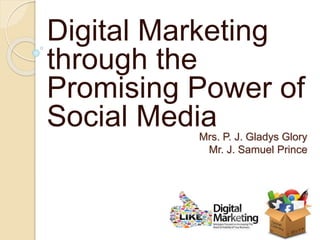Digital Marketing
- 1. Digital Marketing through the Promising Power of Social MediaMrs. P. J. Gladys Glory Mr. J. Samuel Prince
- 2. Old Marketing Objective Stop fabricating Telemarketing Direct mailing Relying on hard data and stats Customer’s need to be reach you. Fake testimonials. Communicate with unknown audience
- 3. Digital Marketing Objective • Defining digital ambitions and strategies. • Selecting critical initiatives to improve their e-business maturity model. • Using digital channels to upgrade their brand experience.
- 6. Digital Marketing Offers • Digital Experience. • Social Collaboration. • Work Force Management. • Unified Communications
- 7. Digital Marketing - Three Keys • Manage complex customer relationships across a variety of channels – both digital and traditional. • Respond to and initiate dynamic customer interactions. • Extract value from big data to make better decisions faster.
- 8. Digital Marketing - Three Keys
- 10. Digital Marketing ExperienceDigital Experience software is uniquely designed to help create, manage, simplify and integrate your processes to meet these demands by incorporating capabilities such as: Mobile Experiences: Build engaging mobile experiences that display perfectly on smart phones, tablets or computers. Content and mobile applications can be dynamically rendered on any device, giving marketers more flexibility in creating engaging sites for users across all digital touch points. Analytics & Optimization: Enhanced tagging, SEO capabilities and integration with solutions provide social listening and analysis tools as well as out of the box Web In-context analytics. We can easily measure performance, understand user needs and develop targeted campaigns.
- 11. Continues…. Rich Media Management: Digital Marketing has simplified the process of editing, publishing and managing Web content. Teams can incorporate rich media across both Web and mobile channels without having to rely on support from IT and create more targeted experiences for their customers. Social Technologies: Become more agile with the ability to conduct in-place, real-time Web page and channel delivery analysis on a company portal or on an external social networking site to quickly make insightful business decisions and determine the sentiment of customers and employees. .
- 12. Digital Marketing- Trends • Content marketing is still king • Real time marketing is not just a hype • Desktops will be substituted with mobile devices and tablets. • Mobile engagement will surge • Mobile advertising will also grow • Visual media will dominate the market in 2014 • Content marketing will be more targeted. It’s relevant, timely and simply clever • Challenger brands will conquer in the 2014 digital landscape • More B2B marketers will use Slideshare • Smarter social media marketing
- 13. Digital Marketing -Become a people business
- 14. Digital Marketing According to IBM, 95 percent of what are termed standout organizations will focus more on getting closer to the customer over the next five years and 57 percent are more likely to allow their people to use social and collaborative tools. It’s not a coincidence. Leading organizations are using social collaboration to delight customers, to drive innovation, and to bring out the best in their business networks and employees. IBM has the tools and expertise to help you maximize the value of social collaboration in business environments, including profiles, blogs, wikis, bookmarking, tagging, activities, communities, shared files, team spaces with content management tools, enterprise instant messaging, online meetings, audio and video chat, email and calendaring, delivered on premises or in the cloud.















